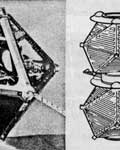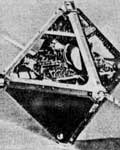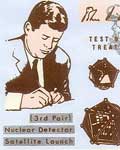ERS 17 & 18
Environmental Research Satellites 17 & 18

Spacecraft
The basic configuration of the ERS 17/18 spacecraft is a regular octahedron measuring 11 inches (28 cm) on a side. Solar cells mounted on each side of the faces provide sufficient electrical power to operate the experiments and and the telemetry system when the satellite is illuminated by the sun. No internal battery or command system were provided. The satellite subsystems consisted of electrical power, antenna, telemetry, experiments, and mechanical structure.
Detectors sensitive to trapped particles included a solid state detector for electron fluxes above 0.4 MeV and protons 8-21 MeV, a low energy scintillation counter for electrons >100 keV and protons 3-27 MeV, and a high energy scintillation counter which measured electrons >3 MeV and protons >35 MeV. The UCSD Gamma-Ray Telescope measured gamma-rays between 30 keV and 10 MeV and provided a measure of total cosmic ray flux. A set of Geiger-Muller counters detected solar X-rays in the 1-14 Angstrom range and electrons above 40 keV. ERS-17
Instrument Complement
Detector |
Absorber |
Electrons |
Protons |
X-rays |
|---|---|---|---|---|
Geiger Counters |
1.2 mg/cm2 Mica |
>40 keV |
>750 keV |
0.9-12 keV |
Solid State Detector |
68.5 mg/cm2 Aluminum |
>400 keV |
8-21 MeV |
|
Low Energy PMT |
8.9 mg/cm2 Aluminum |
>100 keV |
3-27 MeV |
|
High Energy PMT |
~1.6 gm/cm2 |
>3 MeV |
>35 MeV |
|
~2 gm/cm2 |
|
|
33 keV - 10 MeV |
ERS-18 Instrument Complement
Detector |
Absorber |
Electrons |
Protons |
X-rays |
|---|---|---|---|---|
Geiger Counters |
1.2 mg/cm2 Mica |
>40 keV |
>750 keV |
0.9-12 keV |
Solid State Detector |
68.5 mg/cm2 Aluminum |
>400 keV |
8-21 MeV |
|
Low Energy PMT |
8.9 mg.cm2 Aluminum |
>100 keV |
|
|
Surface Barrier |
0.3 mg/cm2 Nickel |
|
0.4-2.9 MeV |
|
4.4 gm/cm2 |
|
|
1-3 MeV |
|
~2 gm/cm2 |
|
|
0.25-6 MeV |
The completed satellite weighed 14.4 pounds (6.55 kg). The solar cells on each octahedron face provided about 4 Watts of unregulated power. The instruments received 0.6 Watts at 9 Volts. Thermal control was achieved through passive thermal design, and 20oC was the nominal temperature with excursions to freezing during perigee eclipses (~30 minute duration). A sun sensor allowed estimation of the spin axis aspect with respect to the solar direction.
ERS 17 & 18 Information
Mission Objectives
Spacecraft
Gamma-ray Counters
Scientific Results
Publications


